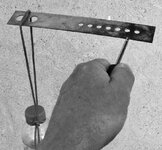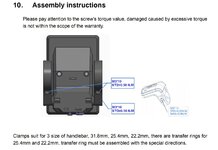spokewrench
Active Member
- Region
- USA
In 2021 I had a puncture so small that it was intermittent. The tire might hold pressure very well for a week, then go flat overnight. At one point, I thought the schrader valve must be erratic. As I read about these valves, it appeared to me that the proper torque for the core had changed. It used to be 2 inch pounds, which you could apply with your fingertips on a valve cap with a key. The recommended torque may have changed 30 or 40 years ago, when valve cores began using gaskets of a harder material than rubber.
Nowhere could I find how many inch pounds are now recommended, so I bought a Slime Valve Core Torque tool. Trying to get it to click, I turned the core so hard that I was afraid I'd tear the rubber valve stem. I stopped, grabbed the stem with pliers to keep it from twisting, and turned the tool until it clicked. I don't think it would be possible to apply so much torque with a valve cap.
To find how much torque was required to click the tool, I found a metal strap that would fit the slot in the tool. I hung a soda bottle on the end of the strap and adjusted the amount of water in the bottle until I found what was just enough weight to make it click. It was 5 inch pounds. That's only 0.42 foot pounds or 0.57 newton meters, but it feels like an awful lot to apply to a valve core.
Two months ago I replaced my new OEM front tire with a Schwalbe. A few weeks ago, it began losing air so fast that I took the wheel off to see if I could find the puncture in the tube. When I started to remove the valve core, it wasn't tight. I tightened it and added air. Now it holds pressure.
When I mounted the new tire, I'd reinstalled the valve core with a core tool, but I didn't use the torque tool and didn't turn it so hard that I needed to grab the stem with pliers. I guess I didn't tighten it enough to keep that hard, slick, modern gasket from turning in use. If I have more trouble, I'll grab the stem with pliers and use the Slime torque tool.
Nowhere could I find how many inch pounds are now recommended, so I bought a Slime Valve Core Torque tool. Trying to get it to click, I turned the core so hard that I was afraid I'd tear the rubber valve stem. I stopped, grabbed the stem with pliers to keep it from twisting, and turned the tool until it clicked. I don't think it would be possible to apply so much torque with a valve cap.
To find how much torque was required to click the tool, I found a metal strap that would fit the slot in the tool. I hung a soda bottle on the end of the strap and adjusted the amount of water in the bottle until I found what was just enough weight to make it click. It was 5 inch pounds. That's only 0.42 foot pounds or 0.57 newton meters, but it feels like an awful lot to apply to a valve core.
Two months ago I replaced my new OEM front tire with a Schwalbe. A few weeks ago, it began losing air so fast that I took the wheel off to see if I could find the puncture in the tube. When I started to remove the valve core, it wasn't tight. I tightened it and added air. Now it holds pressure.
When I mounted the new tire, I'd reinstalled the valve core with a core tool, but I didn't use the torque tool and didn't turn it so hard that I needed to grab the stem with pliers. I guess I didn't tighten it enough to keep that hard, slick, modern gasket from turning in use. If I have more trouble, I'll grab the stem with pliers and use the Slime torque tool.


